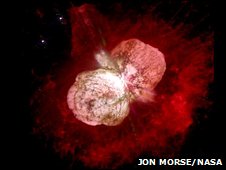| ||||||||||||||||||||||||||||||||||||||||||||||||||||||||||||||||||||||||
|
Astronomers2 have revealed faint images of the two oldest and most distant supernovae to be discovered to date. 宇航员日前发布了两颗年龄最大的、最遥远的超新星的模糊照片。 When a massive star effectively runs out of nuclear fuel, it explodes in a supernova - hurling3 much of its material into space. The scientists described in the journal Nature how they gathered images of the exploding stars by monitoring the same galaxies4 over five years. They used multiple images to pick out supernovae in the distant Universe. The furthest two supernovae the team found occurred about 11 billion years ago. Mark Sullivan, an astronomer1 from the University of Oxford5 in the UK, was one of the authors of the study. He explained that these stars exploded about 2.5 billion years after the Big Bang. "As a point of reference(参考点,基准点), the universe is currently about 13.5 billion years old," said Dr Sullivan. The team gathered their data using the Canada-France-Hawaii telescope on Mauna Kea in Hawaii. "We took all of the data in and combined it together," said Dr Sullivan. "So instead of just using at data taken in a single night, which would typically be a single hour we had several hours worth of (images)." The faint light from the aftermath(余波) of the huge stellar(星) explosions was visible for several months, so the scientists were able to isolate6 it from the blur7 of the galaxies in which they occurred. "What we're looking for are things that were there one year, but which weren't there the next," explained Dr Sullivan. "You see an image of the galaxy8 in which a supernovae exploded. When you subtract the two years' data, the galaxy disappears, because it hasn't changed. So you're just left with things that have changed - in this case that's the supernovae." Dr Sullivan said that this new technique opened up exciting possibilities for future experiments. "We have shown that this is the way in which we can find the most distant cosmic explosions," he told BBC News. Seeing stars Ancient supernovae can reveal important clues about the birth of the Universe. "Elements such as iron, calcium9 and nickel are manufactured by these massive stars," explained Jeff Cooke, from the University of California, Irvine, who was also involved in the study. "Upon their explosive death, they eject this material into space and 'pollute' their environments. This material then cools and can form recycled stars with disks of material around them that can then form planets." By "looking back 11 billion years into the past", Dr Cooke said that these new discoveries will help astronomers to understand exactly how this process works. "Moreover, the new method that we use here will allow us to observe as far back as 12 and a half billion years to witness some of the very first stars ever." 点击  收听单词发音 收听单词发音
|
||||||||||||||||||||||||||||||||||||||||||||||||||||||||||||||||||||||||
- 发表评论
-
- 最新评论 进入详细评论页>>




